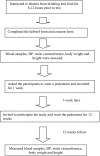Increasing walking steps daily can reduce blood pressure and diabetes in overweight participants
- PMID: 30603352
- PMCID: PMC6224870
- DOI: 10.1007/s13340-017-0333-z
Increasing walking steps daily can reduce blood pressure and diabetes in overweight participants
Abstract
Background: High blood pressure (BP) and diabetes have been suggested to be non-communicable diseases (NCDs), and they are components in the definition of metabolic syndrome. Further, several studies have reported that the risk of developing NCDs can be reduced by increased physical activity. In addition, a daily target of 10,000 steps has been generally suggested to increase physical activity in sedentary lifestyles. Therefore, the purpose of this study was to determine the effect of an accumulation of 10,000 steps daily on BP and blood glucose in overweight participants.
Methods: Participants were recruited from males and females, aged 35-59 years, with sedentary lifestyles. A longitudinal quasi-experimental study was designed with 35 participants who had body mass indices ≥25 kg/m2. These volunteers were assigned to the 12-week pedometer-based walking program (an accumulation of at least 10,000 steps daily). Blood glucose and BP were measured before and after the intervention.
Results: Systolic blood pressure (SBP) was significantly lower in 30 individuals who accumulated 10,000 steps daily (-13.74 mmHg). In addition, the reduction of blood glucose levels (-14.89 mg/dl) in the intervention participants was statistically significant (p < 0.001).
Conclusion: The accumulation of at least 10,000 steps daily resulted in decreased SBP and blood glucose in overweight Thai subjects. It could also reduce the risk of cardiovascular disease (e.g., hypertension and diabetes).
Keywords: Blood glucose; Blood pressure; Diabetes; Physical activity; Walking.
Conflict of interest statement
There is no conflict of interest in the present study.All procedures followed were in accordance with the ethical standards of the responsible committee on human experimentation (Thammasat University, Thailand) and with the Helsinki Declaration of 1964 and later versions. Informed consent or a substitute for it was obtained from all patients for being included in the study.
Figures
Similar articles
-
The effects of an incremental approach to 10,000 steps/day on metabolic syndrome components in sedentary overweight women.J Phys Act Health. 2010 Nov;7(6):737-45. doi: 10.1123/jpah.7.6.737. J Phys Act Health. 2010. PMID: 21088304 Clinical Trial.
-
Increasing daily walking improves glucose tolerance in overweight women.Prev Med. 2003 Oct;37(4):356-62. doi: 10.1016/s0091-7435(03)00144-0. Prev Med. 2003. PMID: 14507493 Clinical Trial.
-
Dose-effect relationship between brisk walking and blood pressure in Chinese occupational population with sedentary lifestyles: Exercise and blood pressure.J Clin Hypertens (Greenwich). 2021 Sep;23(9):1734-1743. doi: 10.1111/jch.14340. Epub 2021 Aug 13. J Clin Hypertens (Greenwich). 2021. PMID: 34390121 Free PMC article.
-
Effects of 10,000 steps a day on physical and mental health in overweight participants in a community setting: a preliminary study.Braz J Phys Ther. 2016 Jul-Aug;20(4):367-73. doi: 10.1590/bjpt-rbf.2014.0160. Epub 2016 Jun 16. Braz J Phys Ther. 2016. PMID: 27556393 Free PMC article.
-
Relation of pedometer steps count & self reported physical activity with health indices in middle aged adults.Diabetes Metab Syndr. 2017 Dec;11 Suppl 2:S1017-S1023. doi: 10.1016/j.dsx.2017.07.033. Epub 2017 Jul 22. Diabetes Metab Syndr. 2017. PMID: 28780228
Cited by
-
Walking away from depression: the mediating role of walking activity in depression impacting blood glucose levels of people with diabetes or prediabetes.Front Endocrinol (Lausanne). 2024 Aug 27;15:1446405. doi: 10.3389/fendo.2024.1446405. eCollection 2024. Front Endocrinol (Lausanne). 2024. PMID: 39257900 Free PMC article.
-
Daily Step Count and its Association with Arterial Stiffness Parameters in Older Adults.Ann Geriatr Med Res. 2024 Mar;28(1):101-109. doi: 10.4235/agmr.23.0161. Epub 2024 Feb 13. Ann Geriatr Med Res. 2024. PMID: 38350695 Free PMC article.
-
LIFESTYLE AND ANTHROPOMETRIC INDICATORS HAVE GREATER ASSOCIATIONS WITH STEPS/DAY IN BOYS THAN IN GIRLS.Rev Paul Pediatr. 2020 Dec 14;39:e2019413. doi: 10.1590/1984-0462/2021/39/2019413. eCollection 2020. Rev Paul Pediatr. 2020. PMID: 33331546 Free PMC article.
-
Promoting Healthy Behaviors in Older Adults to Optimize Health-Promoting Lifestyle: An Intervention Study.Int J Environ Res Public Health. 2023 Jan 16;20(2):1628. doi: 10.3390/ijerph20021628. Int J Environ Res Public Health. 2023. PMID: 36674395 Free PMC article.
-
Walking for hypertension.Cochrane Database Syst Rev. 2021 Feb 24;2(2):CD008823. doi: 10.1002/14651858.CD008823.pub2. Cochrane Database Syst Rev. 2021. PMID: 33630309 Free PMC article.
References
-
- Park YW, Zhu S, Palaniappan L, Heshka S, Carnethon MR, Heymsfield SB. The metabolic syndrome: prevalence and associated risk factor findings in the US population from the Third National Health and Nutrition Examination Survey. Arch Intern Med. 2003;163:427–436. doi: 10.1001/archinte.163.4.427. - DOI - PMC - PubMed
-
- Haskell WL, Lee IM, Pate RR, Powell KE, Blair SN, Franklin BA, Macera CA, Health GW, Thompson PD, Bauman A. Physical activity and public health: updated recommendation for adults from the American College of Sports Medicine and the American Heart Association. Med Sci Sports Exerc. 2007;39:1423–1434. doi: 10.1249/mss.0b013e3180616b27. - DOI - PubMed
LinkOut - more resources
Full Text Sources
Medical

